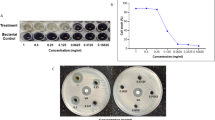Abstract
Antibiotic-resistant strains remain an impor tant public health problem in developing countries, but industri alised countries are not fully protected from this problem either. Recent research has used combinations of traditional ethnopharmacology and modern technologies to find more effective treatments. Green chemical processes are one of these important combinations with herbal medicine. A superheated water extract and a decoction were prepared from clove buds (Syzygium aromaticum (L.) Merr. & L.M. Perry) and evaluated for their antibacterial activity. The obtained extracts were tested against multi-resistant clinical isolates. The superheated extract showed strong antibacterial activity with bactericidal effect against most tested strains, whereas the decoction showed low activity with bacteriostatic effect. Both extracts have a similar global chemical composition; however, the powerful bactericidal activity of the superheated extract is due to greater concentration of polyphenolics. This study reveals the promising potential of clove extracts obtained by a green process using water, heat and pressure.
Similar content being viewed by others
References
Pitout JDD (2010) The latest threat in the war on antimicrobial resistance. Lancet Infect Dis 10:578–579
Deresinski S (2009) Vancomycin in combination with other antibiotics for the treatment of serious methicillin-resistant Staphylococcus aureus infections. Clin Infect Dis 49:1072–1079
Muthaura CN, Keriko JM, Derese S, Yenesew A, Rukunga GM (2011) Investigation of some medicinal plants traditionally used for treatment of malaria in Kenya as potential sources of antimalarial drugs. Exp Parasitol 127:609–626
Liu RH (2003) Health benefits of fruit and vegetables are from additive and synergistic combinations of phytochemicals. Am J Clin Nutr 78:S517–S520
Loza-Tavera H (1999) Monoterpenes in essential oils: biosynthesis and properties. Adv Exp Med Biol 464:49–62
Talib WH, Mahasneh AM (2010) Antimicrobial, cytotoxicity and phytochemical screening of Jordanian plants used in traditional medicine. Molecules 15:1811–1824
Usta J, Kreydiyyeh S, Bajakian K, Nakkash-Chmaisse H (2002) In vitro effect of eugenol and cinnamaldehyde on membrane potential and respiratory chain complexes in isolated rat liver mitochondria. Food Chem Toxicol 40:935–940
Yao LH, Jiang YM, Shi J et al (2004) Flavonoids in food and their health benefits. Plant Foods Hum Nutr 59:113–122
Warner JC, Cannon AS, Dye KM (2004) Green chemistry. Environ Impact Assess Rev 24:775–799
Diaaz-Reinoso B, Moure A, Domingez H, Parajo JC (2006) Supercritical CO2 extraction and purification of compounds with antioxidant activity. J Agric Food Chem, 54:2441–2469
Gallo M, Ferracane R, Graziani G et al (2010) Microwave assisted extraction of phenolic compounds from different spices. Molecules 15:6365–6374
Garcia-Risco MR, Hernandez EJ, Vicente G et al (2011) Kinetic study of pilot-scale supercritical CO2 extraction of rosemary (Rosmarinus officinalis) leaves. J Supercritc Fluids 55:971–976
Güçlü-Üstündağ Ö, Mazza G (2009) Effects of pressurized low polarity water extraction parameters on antioxidant properties and composition of Cow Cockle seed extracts. Plant Foods Hum Nutr 64:32–38
Ozel MZ, Kaymaz H (2004) Superheated water extraction, steam distillation and Soxhlet extraction of essential oils of Origanum onites. Anal Bioanal Chem 379:1127–1133
Thongson C, Davidson PM, Mahakarnchanakul W, Weiss J (2004) Antimicrobial activity of ultrasound-assisted solvent-extracted spices. Lett Appl Microbiol 39:401–406
Benzeggouta N (2012) From ethnopharmacology to green chemistry: olive oil as solvent. Int J Drug Res Tech 2:388–392
Benzeggouta N, Semra Z (2008) Recherche de nouveaux agents antibactériens: extraits de Cinnamomum zeylanicum Nees. JAM XVI:27–30 (http://www.andrs-dz.org/pages/JAM.htm)
Benzeggouta N, Semra Z, Kabouche Z (2012) From ethnopharmacology to green chemistry: “Dawilou” a traditional herbal mixture. Pharmacophore 3:76–80
Rahal K, Benslimani A, Tali-Maamar H et al (2008) Standardisation de l’Antibiogramme en Médecine Humaine à l’Echelle Nationale. Selon les recommandations de l’OMS, 8th edn. Ministère de la Santé, de la Population et de la Réforme Hospitalière, République Algérienne Démocratique et Populaire (http://www.sante.dz/aarn/documents/pdf/standardisationmedhum-2008.pdf)
Benjilali B, Tantaoui-Elaraki A, Ismaïl-Alaoui M, Ayadi A (1986) Méthode d’étude des propriétés antiseptiques des huiles essentielles par contact direct en milieu gélosé. Plantes Médicinales et Phytothérapie 20:155–167
Dohou N, Yamni K, Tahrouch S et al (2003) Screening phytochimique d’une endemique Ibéro-Marocaine, Thymelaea lythroides. Bull Soc Pharm Bord 142:61–78
El-Olemy MM, Al-Muhtadi FJ, Afifi AA (1994) Experimental phytochemistry. A laboratory manual. King Saud University Press, Riyadh, Saudi Arabia
Kumar U, Kumar B, Bhandari A, Kumar Y (2010) Phytochemical investigation and comparison of antimicrobial screening of clove and cardamom. Int J Pharm Sci Res 1:138–147
Senhaji O, Faid M, Elyachioui M, Dehhaoui M (2005) Etude de l’activité antifongique de divers extraits de cannelle. J Mycol Med 15:220–229
Walsh SE, Maillard J-Y, Russell AD et al (2003) Activity and mechanism of action of selected biocidal agents on Grampositive and -negative bacteria. J Appl Microbiol 94:240–247
Braga PC, Dal Sasso M, Culici M, Alfieri M (2007) Eugenol and thymol, alone or in combination, induce morphological alterations in the envelope of Candida albicans. Fitoterapia 78:396–400
Hatano T, Kusuda M, Inada K et al (2005) Effects of tannins and related polyphenols on methicillin-resistant Staphylococcus aureus. Phytochemistry 66:2047–2055
Proestos C, Boziaris IS, Nychas G-JE, Komaitis M (2006) Analysis of flavonoids and phenolic acids in Greek aromatic plants: investigation of their antioxidant capacity and antimicrobial activity. Food Chem 95:664–671
Shan B, Cai YZ, Sun M, Corke H (2005) Antioxidant capacity of 26 spice extracts and characterization of their phenolic constituents. J Agric Food Chem 53:7749–7759
Smyth T, Ramachandran VN, Smyth WF (2009) A study of the antimicrobial activity of selected naturally occurring and synthetic coumarins. Int J Antimicrob Agents 33:421–426
Jayawardena B, Smith RM (2010) Superheated water extraction of essential oils from Cinnamomum zeylanicum (L.). Phytochem Anal 21:470–472
Zancan KC, Marques MOM, Petenate AJ, Meireles MAA (2002) Extraction of ginger (Zingiber officinale Roscoe) oleoresin with CO2 and co-solvents: a study of the antioxidant action of the extracts. J Supercritic Fluids 24:57–76
Author information
Authors and Affiliations
Corresponding author
Rights and permissions
About this article
Cite this article
Benzeggouta, N., Semra, Z. From ethnopharmacology to green chemistry. Nutrafoods 12, 23–27 (2013). https://doi.org/10.1007/s13749-012-0065-4
Received:
Accepted:
Published:
Issue Date:
DOI: https://doi.org/10.1007/s13749-012-0065-4




